A Meatless Twist on a Classic French Dish
If you’re a vegetarian or just looking to cut down on your meat consumption, you may have thought that a classic French dish like boeuf bourguignon was off the table. However, with a few tweaks, you can enjoy all the rich flavors of this hearty stew without any meat. Enter vegetarian boeuf bourguignon.

Traditionally made with beef, bacon, and red wine, this dish is a staple of French cuisine. But by using mushrooms, carrots, and other vegetables, you can create a vegetarian version that’s just as delicious. The key is to use ingredients that have a meaty, umami flavor, like portobello mushrooms, which can give the dish a similar texture and taste to the original.
To make vegetarian boeuf bourguignon, you’ll need to start by sautéing your vegetables in a large pot or Dutch oven. This will help to develop their flavors and create a rich base for the stew. Then, you’ll add in your liquid ingredients, like vegetable broth and red wine, along with herbs and spices like thyme, bay leaves, and garlic. Let everything simmer together for a few hours, and you’ll be left with a hearty, flavorful stew that’s perfect for a cozy night in.
The Origins of Boeuf Bourguignon

Boeuf Bourguignon, also known as Beef Burgundy, is a classic French dish that originated in the Burgundy region of France. This dish is a hearty stew made with beef, vegetables, and red wine. While the dish is traditionally made with beef, there are many vegetarian versions of this dish that use mushrooms or other meat substitutes instead of beef.
Historical Context
The origin of Boeuf Bourguignon is unclear, but many believe that it was invented in the late 19th century by the French chef Auguste Escoffier. Escoffier is considered by many to be the father of modern French cuisine, and he likely created the dish in an effort to showcase the richness and flavor of beef.
The dish gained popularity in the 20th century, and it became a staple of French cuisine. Today, Boeuf Bourguignon is enjoyed all over the world, and it has become a favorite of both home cooks and professional chefs.
Traditional Ingredients
The traditional ingredients of Boeuf Bourguignon include beef, red wine, onions, carrots, garlic, mushrooms, and bacon. The dish is typically cooked slowly over low heat, which allows the flavors to meld together and the meat to become tender and flavorful.
While the traditional recipe calls for beef, there are many vegetarian versions of this dish that use mushrooms or other meat substitutes instead of beef. These vegetarian versions are just as flavorful and hearty as the traditional recipe, and they are a great option for those who are looking for a meatless alternative.
In conclusion, Boeuf Bourguignon is a classic French dish that has been enjoyed for centuries. Whether you are a meat lover or a vegetarian, there is a version of this dish that will suit your tastes. So why not try making a pot of Boeuf Bourguignon tonight and experience the rich flavors and comforting warmth of this classic French dish?
Defining Vegetarianism

If you are new to the concept of vegetarianism, it can be confusing to understand what it entails. Vegetarianism is a dietary practice that involves abstaining from consuming meat, poultry, and seafood. Some vegetarians also avoid consuming animal by-products such as eggs, dairy, and honey.
Vegetarian Diet Basics
Vegetarianism is not a one-size-fits-all diet, as there are different types of vegetarians. The most common types are:
- Lacto-ovo vegetarians: They avoid meat, poultry, and seafood but consume eggs and dairy products.
- Lacto vegetarians: They avoid meat, poultry, seafood, and eggs but consume dairy products.
- Ovo vegetarians: They avoid meat, poultry, seafood, and dairy products but consume eggs.
- Vegans: They avoid all animal products, including meat, poultry, seafood, eggs, dairy, and honey.
Vegetarians can obtain the necessary nutrients from plant-based sources such as fruits, vegetables, legumes, nuts, and seeds. A well-planned vegetarian diet can provide all the essential nutrients your body needs, including protein, iron, calcium, and vitamin B12.
Health Benefits
Research has shown that a vegetarian diet can offer several health benefits. For instance, it can help reduce the risk of chronic diseases such as heart disease, type 2 diabetes, and some types of cancer. Vegetarians tend to have lower body mass indexes (BMIs) and lower blood pressure levels than non-vegetarians.
Incorporating vegetarian meals into your diet can also be an environmentally friendly choice. The production of meat and animal by-products requires more land, water, and energy compared to plant-based foods.
If you are interested in trying out vegetarianism, there are plenty of delicious and nutritious recipes to explore, such as the vegetarian boeuf bourguignon. This meatless version of the classic French dish replaces the beef with mushrooms and other vegetables, making it a hearty and flavorful meal.
Essential Ingredients for Vegetarian Boeuf Bourguignon

If you are planning to make a vegetarian version of the classic French dish Boeuf Bourguignon, there are a few essential ingredients that you need to have on hand. In this section, we will discuss the key ingredients that you need to make a delicious and satisfying vegetarian Boeuf Bourguignon.
Meat Substitutes
The first and most important ingredient that you need for vegetarian Boeuf Bourguignon is a meat substitute. There are several options available, including soy-based products, seitan, and mushrooms. Soy-based products are a popular choice because they have a meaty texture and can be flavored to taste like beef. Seitan is another popular option that is made from wheat gluten and has a chewy texture similar to meat. Mushrooms are also an excellent choice because they have a meaty texture and can be flavored to taste like beef.
Vegetable Broth and Wine
The next key ingredient that you need for vegetarian Boeuf Bourguignon is vegetable broth and wine. Vegetable broth is used as the base for the sauce and provides a rich, savory flavor. Wine is also an essential ingredient because it adds depth and complexity to the sauce. You can use red wine or white wine, depending on your preference. Some recipes call for a combination of both.
To summarize, when making a vegetarian version of Boeuf Bourguignon, you need to have a meat substitute, vegetable broth, and wine. These ingredients are essential for creating a rich, savory sauce that is the hallmark of this classic French dish. Experiment with different meat substitutes and wines to find the combination that works best for you.
Cooking Techniques

Searing and Simmering
Searing the vegetables and mushrooms is an essential step in creating the depth of flavor in a vegetarian boeuf bourguignon. The high heat caramelizes the natural sugars in the vegetables and mushrooms, which adds richness and complexity to the dish.
To sear the vegetables and mushrooms, heat a heavy-bottomed pot or Dutch oven over medium-high heat. Add a small amount of oil and wait until it is shimmering. Then, add the vegetables and mushrooms in a single layer, making sure not to overcrowd the pot. Cook until they are browned and caramelized, stirring occasionally.
After searing, it’s important to simmer the vegetables and mushrooms in a flavorful liquid. This allows the flavors to meld together and creates a rich, savory sauce. Use red wine, vegetable broth, or a combination of both to simmer the vegetables and mushrooms until they are tender and the sauce has thickened.
Layering Flavors
Layering flavors is another important technique in making a vegetarian boeuf bourguignon. Start by sautéing onions, carrots, and celery in the pot until they are soft and fragrant. Then, add garlic and tomato paste to deepen the flavors.
Next, add the seared vegetables and mushrooms to the pot, along with red wine, vegetable broth, and herbs like thyme and bay leaves. These ingredients work together to create a rich, savory sauce that is the hallmark of a great boeuf bourguignon.
To add even more depth of flavor, consider adding umami-rich ingredients like soy sauce or miso paste. These ingredients add a savory, meaty flavor to the dish and make it even more satisfying.
In summary, searing and simmering and layering flavors are two essential techniques in making a vegetarian boeuf bourguignon. By following these techniques, you can create a rich, satisfying dish that is full of flavor.
Recipe Development
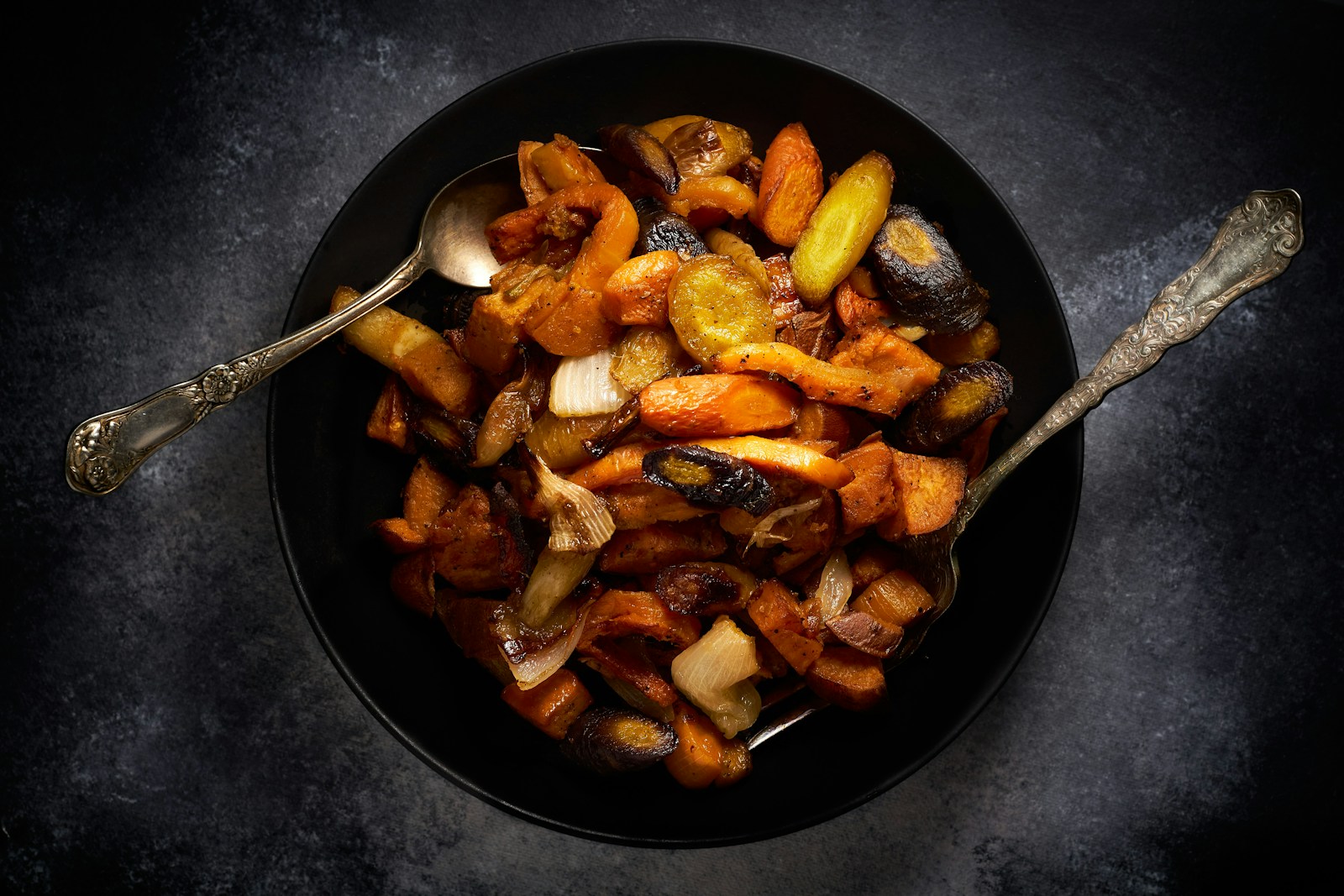
Adapting Classic Recipes
When developing a vegetarian version of boeuf bourguignon, you need to make several adaptations to the classic recipe. The original recipe uses beef as the main ingredient, but you can easily replace it with mushrooms or other vegetables to make it vegetarian-friendly. You also need to replace the beef broth with vegetable broth to maintain the vegetarian status of the dish.
To make the dish more flavorful, you can add a variety of herbs and spices such as thyme, bay leaves, and garlic. Additionally, you can use red wine to add depth and complexity to the dish. However, make sure that the wine you use is vegetarian-friendly, as some wines are processed using animal products such as fish bladder.
Testing for Flavor
When developing a vegetarian boeuf bourguignon recipe, it’s important to test for flavor to ensure that the dish is both delicious and satisfying. One of the best ways to test for flavor is to taste the dish as you cook it. This way, you can adjust the seasoning and spices to your liking.
Another way to test for flavor is to let the dish sit for a few hours or overnight. This allows the flavors to meld together and develop a deeper, richer taste. When you reheat the dish, you can taste it again and adjust the seasoning as needed.
In summary, adapting classic recipes and testing for flavor are two key steps in developing a delicious vegetarian boeuf bourguignon recipe. By making a few simple substitutions and adjusting the seasoning and spices, you can create a vegetarian version of this classic French dish that is just as satisfying and flavorful as the original.
Serving Suggestions

Accompaniments
When serving vegetarian boeuf bourguignon, you can pair it with a variety of side dishes. Some classic options include mashed potatoes, steamed rice, or crusty bread. These sides can help soak up the rich and flavorful sauce of the dish. If you want to add some greenery to your plate, consider serving a simple green salad with a light vinaigrette dressing. The fresh greens can help balance out the hearty flavors of the dish.
For a more creative twist, you can try serving the vegetarian boeuf bourguignon over a bed of roasted root vegetables. The sweetness of the vegetables can complement the savory flavors of the dish. Some great options include roasted carrots, parsnips, and turnips. You can also sprinkle some fresh herbs such as parsley or thyme on top for an extra burst of flavor.
Presentation Tips
When it comes to serving vegetarian boeuf bourguignon, presentation is key. You want to make sure that the dish looks as appetizing as it tastes. One way to do this is by using a shallow bowl or plate to serve the dish. This will allow the sauce to spread out and cover more of the plate, making it more visually appealing.
Another way to elevate the presentation of the dish is by garnishing it with some fresh herbs or chopped vegetables. You can sprinkle some chopped parsley or thyme on top of the dish to add a pop of color and freshness. Alternatively, you can add some sliced mushrooms or caramelized onions on top for an extra layer of flavor and texture.
In conclusion, when it comes to serving vegetarian boeuf bourguignon, there are many options to choose from. You can pair it with classic sides such as mashed potatoes or steamed rice, or get creative with roasted root vegetables. When presenting the dish, use a shallow bowl or plate and garnish it with fresh herbs or chopped vegetables to make it more visually appealing.
Nutritional Information
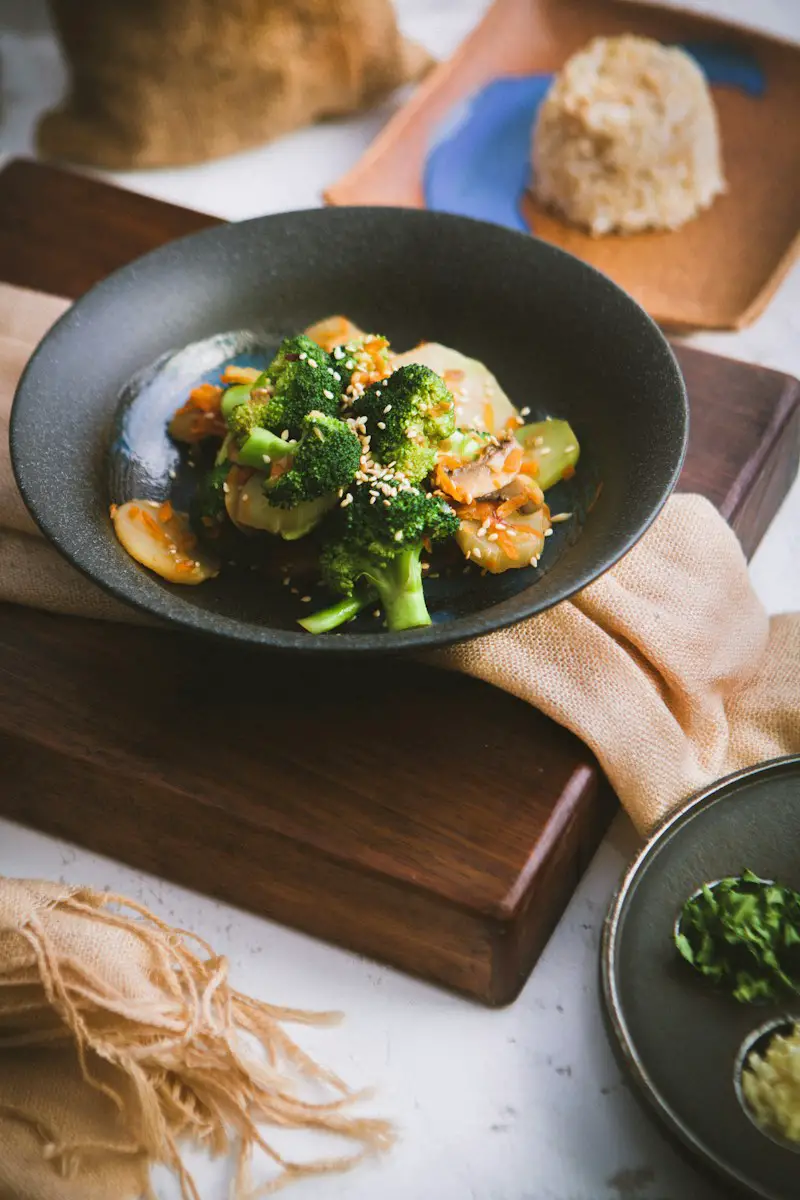
Caloric Content
If you are watching your calorie intake, it is important to know that vegetarian boeuf bourguignon can be quite high in calories. The exact number of calories will depend on the recipe you use and the portion size you consume. However, a typical serving of vegetarian boeuf bourguignon can contain anywhere from 300 to 500 calories.
To reduce the calorie content of your vegetarian boeuf bourguignon, you can try using less oil or butter in the recipe. Additionally, you can opt for lower-calorie ingredients, such as mushrooms, carrots, and onions, instead of using meat. These ingredients are high in fiber and will help you feel full for longer.
Protein and Vitamins
Vegetarian boeuf bourguignon is a good source of protein and vitamins. Protein is essential for building and repairing tissues in your body, and it is especially important for vegetarians who may not consume meat. Mushrooms, one of the main ingredients in vegetarian boeuf bourguignon, are a great source of protein, with 3 grams of protein per 100 grams.
Additionally, vegetarian boeuf bourguignon is a good source of vitamins. The dish typically contains a variety of vegetables, such as carrots, onions, and garlic, which are high in vitamins A and C. These vitamins are important for maintaining healthy skin, eyes, and immune function.
In conclusion, vegetarian boeuf bourguignon can be a nutritious and delicious meal option. By paying attention to the ingredients and portion sizes, you can enjoy this dish without compromising your health goals.
Wine Pairing

When it comes to pairing wine with vegetarian boeuf bourguignon, there are several red wine varietals that complement the dish’s rich flavors. Here are some of the best options:
Red Wine Varietals
- Pinot Noir: This light-bodied red wine has a fruity flavor that pairs well with the earthy mushrooms and carrots in the dish. Look for a Pinot Noir from the Burgundy region of France to complement the traditional French flavors in the dish.
- Syrah/Shiraz: This full-bodied wine has bold flavors of black pepper, dark fruit, and smoke that complement the savory flavors in the dish. Look for a Syrah/Shiraz from the Rhône Valley in France or from Australia to complement the dish’s bold flavors.
- Zinfandel: This medium-bodied wine has a fruity, spicy flavor that pairs well with the dish’s tomato-based sauce. Look for a Zinfandel from California to complement the dish’s American twist on the French classic.
Tasting Notes
Regardless of which red wine varietal you choose, look for a wine with these tasting notes to complement the flavors in the dish:
- Earthy: The dish’s mushrooms and carrots have a natural, earthy flavor that pairs well with a wine that has similar tasting notes.
- Fruity: Look for a wine with fruity tasting notes to complement the sweetness of the onions and carrots in the dish.
- Bold: The dish’s savory flavors call for a wine with bold tasting notes that can stand up to the dish’s rich flavors.
When choosing a wine to pair with vegetarian boeuf bourguignon, keep in mind that the dish’s rich flavors call for a wine with similar tasting notes. Experiment with different red wine varietals to find the perfect pairing for your taste.
Here is a great resource to help you find the perfect wine to pair with your vegetarian boeuf bourguignon.
Adapting for Dietary Restrictions
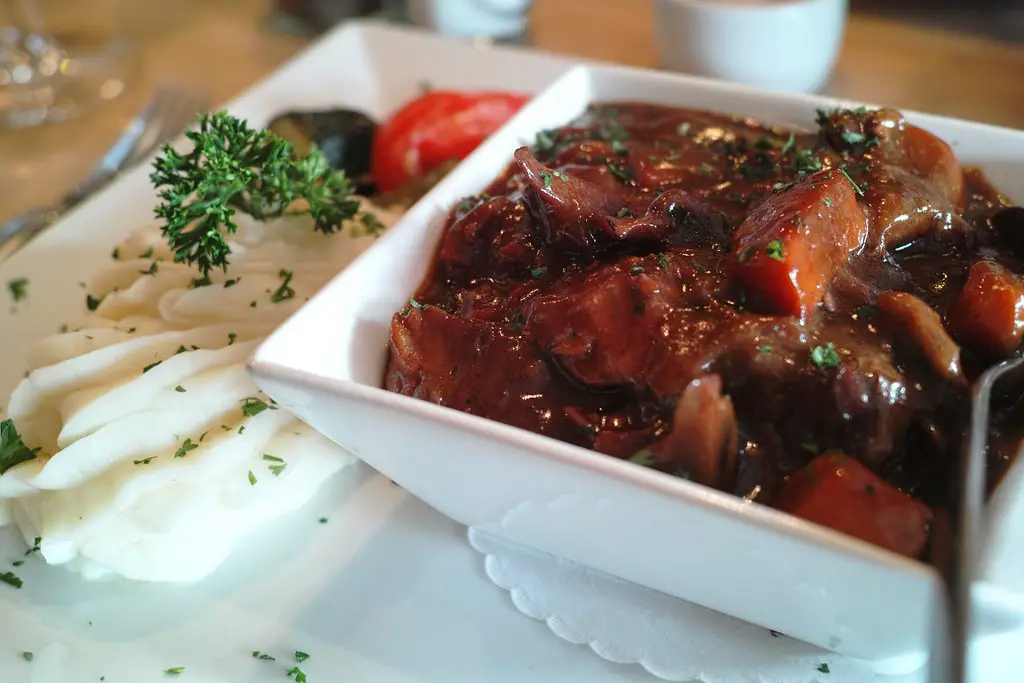
If you have dietary restrictions, you can still enjoy a delicious vegetarian boeuf bourguignon. Here are some modifications you can make to the recipe to accommodate various dietary needs.
Gluten-Free Modifications
If you are gluten-free, you can make a few substitutions to make this recipe gluten-free. Instead of using all-purpose flour to thicken the sauce, you can use a gluten-free flour such as rice flour or cornstarch. You can also use gluten-free pasta or rice instead of whole-wheat pasta as a base for the dish.
Nut-Free Options
If you have a nut allergy, you can omit the nuts and use a different ingredient for added texture. For example, you can use diced mushrooms or diced carrots instead of walnuts. You can also use a different type of nut, such as pecans or almonds, if you are not allergic to those.
Overall, it is important to read the ingredient list carefully and make substitutions as needed to accommodate your dietary needs. With a few simple modifications, you can enjoy a delicious vegetarian boeuf bourguignon that fits your dietary restrictions.
Food Safety and Storage

When it comes to food safety and storage, there are a few important things to keep in mind to ensure that your vegetarian boeuf bourguignon is safe to eat and stays fresh for as long as possible.
Proper Cooling
After cooking your vegetarian boeuf bourguignon, it’s important to cool it down properly before storing it in the refrigerator or freezer. The best way to do this is to divide the stew into smaller portions and place them in shallow containers. This will allow the food to cool down more quickly and evenly.
Once the stew has cooled down to room temperature, you can transfer it to the refrigerator or freezer. Be sure to cover the containers tightly with plastic wrap or lids to prevent any contamination or freezer burn.
Reheating Guidelines
When it’s time to reheat your vegetarian boeuf bourguignon, it’s important to do so safely to avoid any risk of foodborne illness. Here are some guidelines to follow:
- Thaw frozen stew in the refrigerator overnight before reheating.
- Reheat the stew in a saucepan over medium heat, stirring occasionally, until it reaches an internal temperature of 165°F (74°C).
- Do not reheat the stew more than once.
- Discard any leftover stew that has been sitting at room temperature for more than 2 hours.
By following these food safety and storage guidelines, you can enjoy your vegetarian boeuf bourguignon safely and with peace of mind.
Community and Culture

As a vegetarian or someone who is interested in vegetarian cuisine, you are part of a vibrant community that shares your passion for healthy and delicious food. There are many forums and blogs dedicated to vegetarian cooking, where you can find recipes, tips, and advice from other like-minded individuals.
Vegetarian Forums and Blogs
One such forum is the Vegetarian Society, a UK-based organization that has been promoting vegetarianism since 1847. Their website offers a wealth of information on vegetarianism, including recipes, news, and events. Another popular forum is HappyCow, which provides a comprehensive directory of vegetarian and vegan restaurants and stores around the world.
If you are looking for blogs on vegetarian cooking, there are many to choose from. The Minimalist Baker is a popular blog that focuses on simple, plant-based recipes that are easy to make. Oh She Glows is another great blog that features healthy, vegan recipes that are both delicious and nutritious.
Culinary Events
Attending culinary events is a great way to connect with other foodies and learn more about vegetarian cuisine. Many food festivals and markets feature vegetarian and vegan options, making it easy to sample a variety of dishes. The Veg Fest UK is a popular event that takes place annually and features a wide range of vegetarian and vegan food, as well as talks and workshops on health and sustainability.
If you are interested in learning more about vegetarian cooking, you may want to consider taking a cooking class. The Natural Gourmet Institute in New York City offers a variety of classes on vegetarian and vegan cooking, as well as workshops on health and wellness.
In conclusion, the vegetarian community is a welcoming and supportive group of individuals who share a passion for healthy and delicious food. Whether you are looking for recipes, advice, or culinary events, there are many resources available to help you on your journey.
Frequently Asked Questions

What can be used as a meat substitute in vegetarian boeuf bourguignon?
There are several options for meat substitutes in vegetarian boeuf bourguignon. Some popular options include mushrooms, textured vegetable protein, seitan, and lentils. Each of these options can provide a meaty texture and absorb the flavors of the dish.
How does one adapt traditional boeuf bourguignon to a vegetarian version?
To adapt traditional boeuf bourguignon to a vegetarian version, simply replace the beef with a meat substitute, such as mushrooms or lentils. You can also use vegetable broth instead of beef broth. The rest of the recipe can remain the same, including the red wine, garlic, and herbs.
What are the key spices and herbs for an authentic vegetarian bourguignon flavor?
The key spices and herbs for an authentic vegetarian bourguignon flavor include thyme, bay leaves, garlic, and black pepper. These ingredients will help to create a rich, savory flavor that is similar to the traditional meat-based version.
Is it possible to make a vegetarian boeuf bourguignon in a slow cooker?
Yes, it is possible to make a vegetarian boeuf bourguignon in a slow cooker. Simply follow the recipe as usual, but instead of cooking on the stovetop, transfer the ingredients to a slow cooker and cook on low for 6-8 hours or on high for 3-4 hours.
What are some healthy ingredient options for vegetarian boeuf bourguignon?
Some healthy ingredient options for vegetarian boeuf bourguignon include using a variety of vegetables, such as carrots, onions, and mushrooms, and using whole grains, such as brown rice or quinoa, as a base. You can also use low-sodium vegetable broth and limit the amount of added salt.
How does vegetarian boeuf bourguignon differ nutritionally from its meat-based counterpart?
Vegetarian boeuf bourguignon is generally lower in calories, fat, and cholesterol than its meat-based counterpart. It is also higher in fiber and certain nutrients, such as potassium and vitamin C, due to the increased use of vegetables in the recipe.
External Links
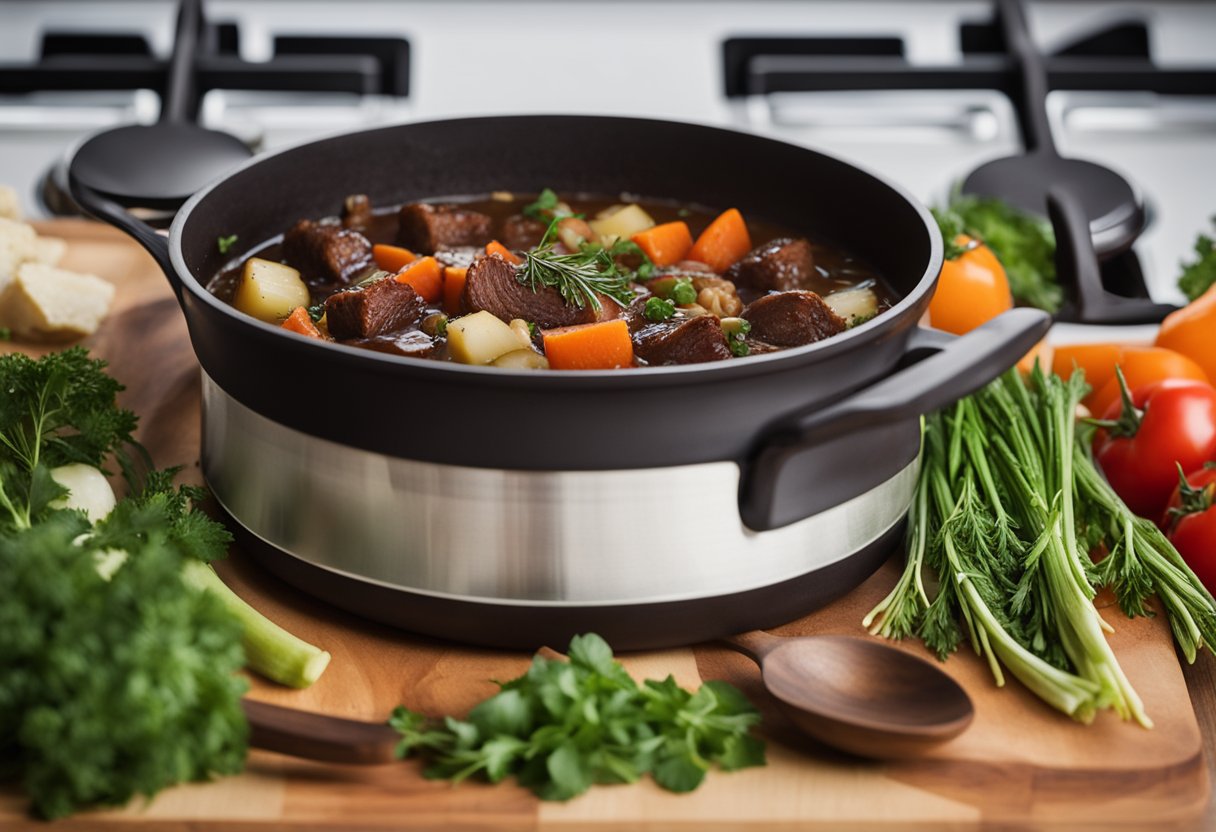
If you’re looking for more information on vegetarian boeuf bourguignon, there are plenty of resources available online. Here are a few external links that you might find helpful:
- Giadzy’s Vegetarian Boeuf Bourguignon – This recipe from Giadzy is a vegetarian twist on the classic French dish. It uses mushrooms and lentils for a meaty texture, and is flavored with red wine and herbs.
- EatingWell’s Vegetarian Bourguignon – This recipe from EatingWell uses root vegetables like carrots and parsnips, along with mushrooms, to create a hearty vegetarian stew. It’s perfect for a cold winter night.
- Ceara’s Kitchen’s Vegan Beef Bourguignon – This vegan version of boeuf bourguignon from Ceara’s Kitchen uses a mushroom and red wine reduction sauce for a deep, rich flavor. It’s a great option for those following a plant-based diet.
- Gourmandelle’s Vegan Beef Bourguignon – This recipe from Gourmandelle uses textured soy protein to create a meaty texture, along with a flavorful broth made from red wine and herbs.
Each of these recipes offers a unique take on vegetarian boeuf bourguignon, so be sure to check them out and find the one that works best for you.
More FAQs
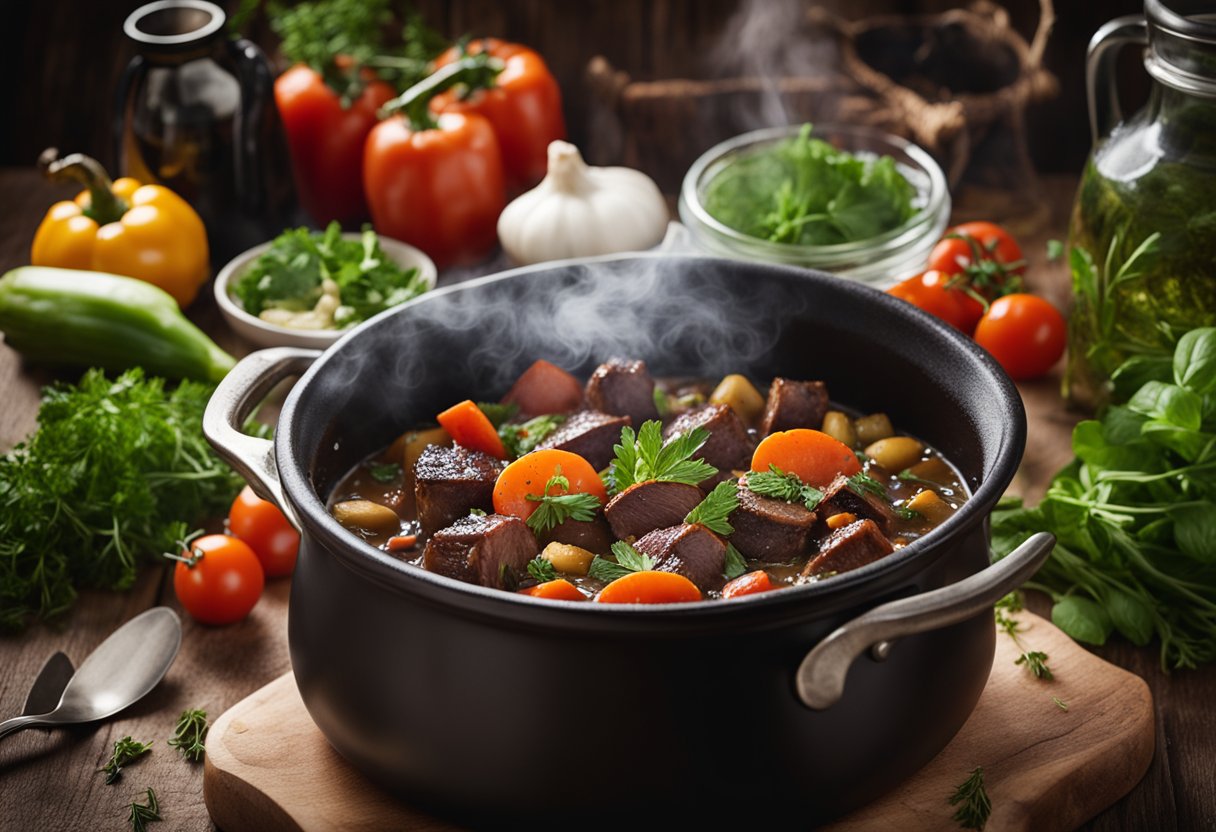
What are some good side dishes to serve with vegetarian boeuf bourguignon?
Vegetarian boeuf bourguignon is a hearty and flavorful dish that pairs well with a variety of side dishes. Here are a few options to consider:
- Mashed Potatoes: Creamy mashed potatoes are a classic choice to serve with boeuf bourguignon. The potatoes will help soak up the rich sauce and provide a nice contrast in texture.
- Roasted Vegetables: Roasting vegetables such as carrots, parsnips, and Brussels sprouts will bring out their natural sweetness and add some color and variety to your plate.
- Crusty Bread: A loaf of crusty bread is perfect for sopping up the delicious sauce in your boeuf bourguignon. You can also use the bread to make a sandwich with the leftover stew the next day.
- Egg Noodles: Serve your vegetarian boeuf bourguignon over a bed of egg noodles for a classic and comforting meal.
What is the best meat to use for traditional boeuf bourguignon?
Traditionally, boeuf bourguignon is made with beef chuck or beef round roast. These cuts of meat are tough and require a long cooking time to become tender and flavorful. However, if you’re looking for a vegetarian alternative, you can use mushrooms, lentils, or seitan to mimic the texture and flavor of the beef.
What type of wine should you use to make boeuf bourguignon?
Red wine is an essential ingredient in boeuf bourguignon, as it adds depth and complexity to the dish. The most commonly used wine is a Burgundy, which is a red wine from the Burgundy region of France. However, you can also use a Pinot Noir or a Syrah if you prefer. Just make sure to choose a wine that you enjoy drinking, as the flavor will be concentrated in the sauce.
Conclusion
Congratulations! You’ve successfully made a delicious and hearty vegetarian version of the classic French dish, boeuf bourguignon. By using mushrooms, carrots, and other vegetables, you’ve been able to create a dish that is both flavorful and nutritious.
Remember to use a good quality red wine to add depth and richness to the sauce. You can also experiment with different types of mushrooms to create different textures and flavors.
Overall, this vegetarian boeuf bourguignon is a great option for those looking to reduce their meat consumption without sacrificing flavor. It’s a perfect dish for a cozy night in or for impressing guests at a dinner party.
Enjoy your creation and don’t forget to share it with your loved ones!
PrintVegetarian Boeuf Bourguignon Recipe
Vegetarian Bourguignon
- Prep Time: 15 minutes
- Cook Time: 40 minutes
- Total Time: 55 minutes
- Yield: 4 servings 1x
- Category: Main Dish
- Method: Stovetop, Simmering
- Cuisine: French-inspired Vegetarian
- Diet: Vegetarian
Ingredients
- 2 tablespoons olive oil
- 1 large onion, finely chopped
- 3 cloves garlic, minced
- 2 carrots, peeled and sliced
- 2 parsnips, peeled and sliced
- 1 cup mushrooms, sliced
- 1 cup pearl onions, peeled
- 2 tablespoons all-purpose flour
- 1 cup red wine
- 2 cups vegetable broth
- 2 tablespoons tomato paste
- 1 teaspoon dried thyme
- 2 bay leaves
- Salt and pepper to taste
- 1 pound baby potatoes, halved
- Fresh parsley for garnish
Instructions
- Heat olive oil in a large pot over medium heat. Add chopped onions and garlic, sauté until softened.
- Add carrots, parsnips, mushrooms, and pearl onions. Cook until vegetables are slightly browned.
- Sprinkle flour over the vegetables, stir well, and cook for 2 minutes.
- Pour in red wine, scraping the bottom of the pot to release any browned bits. Add vegetable broth, tomato paste, thyme, bay leaves, salt, and pepper. Stir to combine.
- Add halved baby potatoes and bring the mixture to a simmer. Cover and let it simmer for 30-40 minutes, or until vegetables are tender.
- Garnish with fresh parsley before serving.
Notes
This vegetarian twist on the classic French dish captures the rich flavors of traditional boeuf bourguignon without the meat. The combination of red wine, vegetables, and herbs creates a hearty and satisfying stew that pairs well with crusty bread or over a bed of mashed potatoes. Adjust the seasoning according to your taste preferences, and feel free to experiment with different vegetables for added variety. Enjoy this comforting dish on cozy evenings for a taste of French-inspired vegetarian goodness.
Nutrition
- Serving Size: 1 serving
- Calories: 320
- Sugar: 8g
- Sodium: 650mg
- Fat: 8g
- Carbohydrates: 50g
- Fiber: 9g
- Protein: 6g
- Cholesterol: 0mg
Keywords: Vegetarian Boeuf Bourguignon

